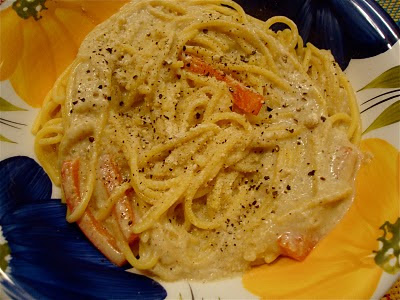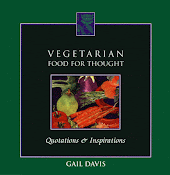Every time I've ordered Pad Thai at any Thai restaurant anywhere in the world, it has pretty much tasted the same. Sure, there were slight nuances in flavor, and sometimes on less fortunate occasions, the noodles would be undercooked or stuck together in a big blob. (Apparently there's some trick to not over- or under-cooking the noodles.) But generally speaking, unlike Panang Curry, which seems to vary widely in flavor from place to place, Pad Thai sauce always tastes pretty much the same to me. Not that I don't love it. It's just that when it comes to the overall flavor, ordering Pad Thai has always been predictable. And that's not a bad thing.
But I recently read that there are as many ways to prepare Pad Thai as there are snowflakes. Okay, well maybe not
that many ways, but according to Chat Mingkwan, author of the treasured vegan recipe book,
Buddha's Table, "Each chef has a signature version of this quintessential Thai dish, differing in ingredients, techniques, and leading flavors." Hmmm ...
verrry interesting.
Since we stopped eating out at Thai restaurants when we started the McDougall diet several months ago, Pad Thai is one dish I've been starting to crave. How fortunate that I found
Mary McDougall's recipe for Pad Thai hiding within the pages of
The McDougall Quick and Easy Cookbook.

The flavors in Mary's dish were more subtle than the bang-you-over-the-head zestiness (and the fried tofu) of the restaurant-style dish I am accustomed to. But it had a lovely mix of flavors, and didn't leave me with the heavy feeling I sometimes experienced after eating the often oil-drenched dish served at restaurants.
But I still wanted to try to find a recipe that came a bit closer to reproducing that restaurant-style flavor. So I tried the Stir-Fried Thai Noodles recipe from
Buddha's Table. Leaving out the oil and the peanuts, it tasted delicious, but still not like the classic restaurant dish. Which is fine by me. I'll just have to keep experimenting. Both times my noodles cooked perfectly, too. I don't know if it was beginner's luck, or just my ability to follow directions precisely.

I think that next time I prepare this recipe I'll use half the tamarind liquid and sugar. The recipe will look like this:
Ingredients:
8 oz. dried chantaboon rice noodles
1/4 cup water
2 Tbs minced garlic
3 cups sliced shiitake mushrooms
1/8 cup evaporated cane crystals
1/4 cup light soy sauce
1 Tbs tamarind liquid (available at Asian grocery stores)
2 Tbs distilled white vinegar
1 Tbs paprika or chili powder
3 Tbs minced preserved turnips (available at Asian grocery stores)
1 pkg Smoked Tofu or Baked Thai Spicy Tofu, sliced thin
3 cups mung bean sprouts
1/2 cup sliced green onion
1/2 cup juilienne red bell peppers
1 whole lime cut into quarters for accompaniment
Soak the rice noodles in warm water until soft and pliable, about 30 minutes. Check the water temperature occasionally. If it is no longer warm, refresh the water. (I did this twice.) Drain and set noodles aside.
Heat a wok or large skillet on high heat. Add water and garlic and cook until fragrant, about 2 minutes. Add the mushrooms and stir-fry for 3 minutes. Add the soaked and drained noodles and stir until well coated.
Add the sugar, soy sauce, tamarind liquid, vinegar, and paprika or chili powder. Stir-fry the mixutre until thoroughly combined and liquid is absorbed. Stir in the tofu and preserved turnips. Check the noodle texture; it should be cooked and soft. Add some water if the noodles are too dry or too tough. (If they fall apart easily, they are overcooked. But this wasn't an issue for me, I think because I didn't over "cook" them in the warm water.)
Stir in the bean sprouts, red bell pepper, and green onion. Continue stir-frying until heated through and well combined. Adjust the flavor with more soy sauce, vinegar, and sugar to taste. Transfer to individual plates and garnish with crushed peanuts, if desired. Serve with fresh bean sprouts and lime wedges to be squeezed over dish. Serves 4.
































